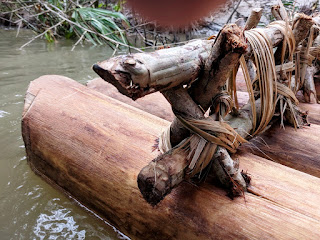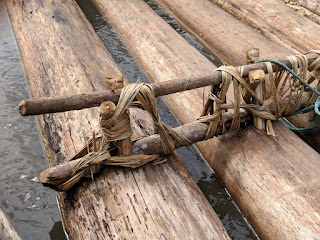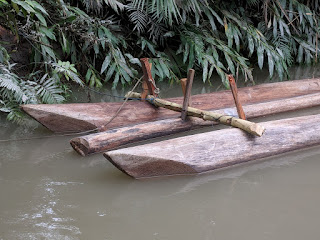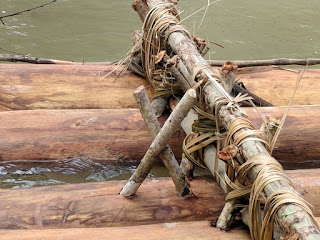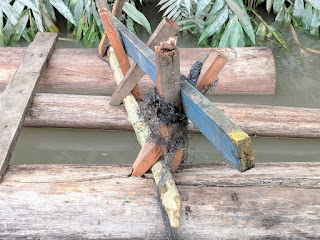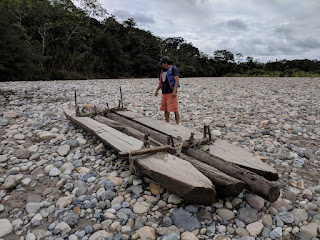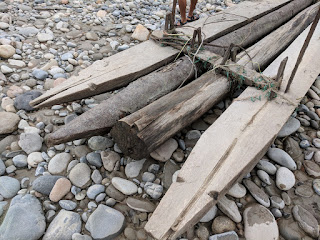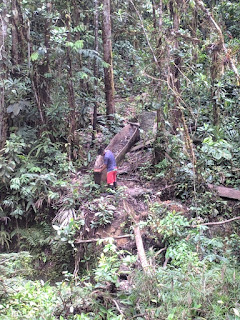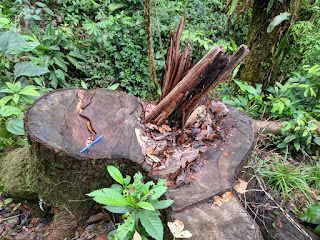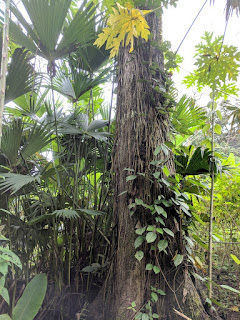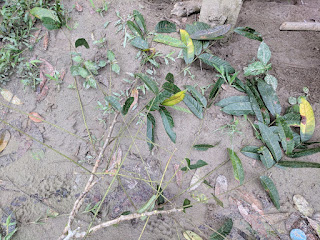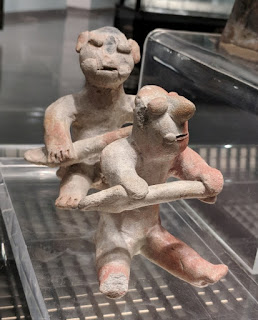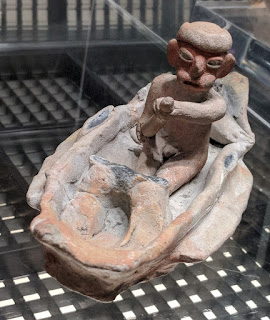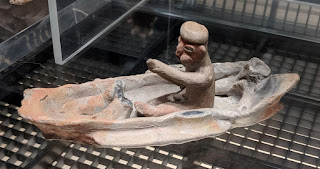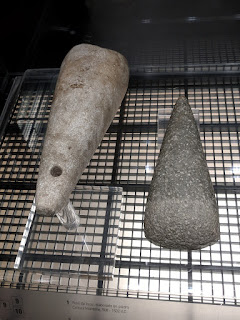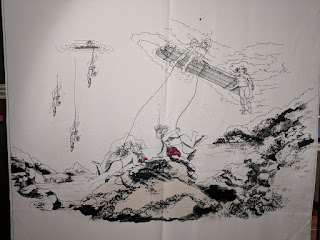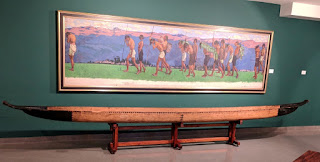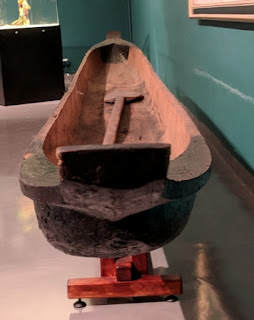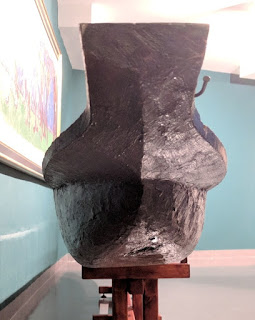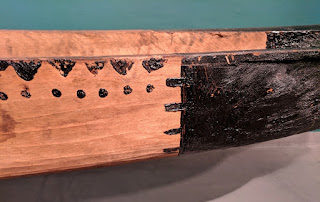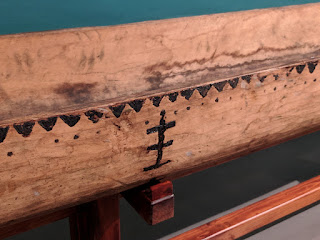In the prior post we examined the watercraft of the Madan or Marsh Arabs. Now we'll look at how the Madan used those boats -- particularly the plank-built ones. As in the last post, all the photos and essentially all the content are from The Marsh Arabs by Wilfred Thesiger.
Almost all of the economic activities of the Madan depended upon their boats. The most important were raising buffaloes, fishing,
wildfowling, reed cutting, mat-making, and smuggling. Others included raising
sheep and goats and growing wheat, barley, and rice. Some entire communities
specialized in boat building.
 |
| Huge stacks of rolled mats at the extreme right and left of the image are ready for export downstream. (Click any image to magnify.) |
Mat-making relied upon the reeds and rushes that were ubiquitous in the marshes. Two passages from The Marsh Arabs are illustrative:
“We passed . . . a large two masted boat loaded high with reed
mats, being laboriously poled toward the Tigris. Later we passed a great raft
made of dry reeds. Forty feet long and ten feet high, it was aground and
temporarily abandoned. When the water-level rose, this stack of reeds would be
floated downstream, perhaps as far as Basra, and there broken up and sold.”
and
“The Nuafil [one of the many tribes Thesiger visited] kept some
buffaloes, but their livelihood depended on the weaving of mats, which they exported
in great numbers. Large sailing boats, like the one we had already seen,
fetched the mats when the water was deep enough.”
Although the Madan, as devout Moslems, do not eat pig, they
frequently mounted hunting expeditions in which several boatloads of men would
go after the wild pig that abounded in the marshes and played havoc with their
crops. Some of the hunting may have been done for the pure sport of it,
however.
 |
| Boats congregating in great numbers on market days. |
Aside from economic uses, virtually every aspect of life in the
marshes depended upon boats. All visits to other villages, for courting,
weddings, funerals, the prosecution of feuds, visits by itinerant circumcisers,
etc., were made by boat. As few of the reed islands or marsh dwellers had
privies, the call of nature was often answered by hopping into a canoe,
paddling a short way off, and squatting over the side. Drinking water, by the
way, was drawn from the same source.
 |
| Even with full load of passengers, there are still several inches of freeboard on this balam. Three men are paddling: one in the bow, and two (on opposite sides) in the stern. |
Thesiger described a scene in which a family was moving their
settlement by boat:
“Two boys in a canoe urged on half a dozen buffaloes, following
behind a balam that was paddled by an
elderly man and another boy, who made yodelling cries to encourage the swimming
animals. A woman and three small children, one of them wearing nothing but a
silver collar round his neck, shared the back of the boat with two buffalo
calves, a kitten, and a lot of hens. The front was piled high with their
belongings, including the dismantled framework of their house, reed mats, water
jars, cooking pots, sacks of grain and a pile of quilts. A dog stood on top of
all this between the wooden legs of a churn, and barked at us as we edged
past.”
As a social convention, it was customary for a man in boat to
greet a man on shore first, rather than the reverse, and for boats traveling downstream
to issue the first greeting to those traveling upstream. Perhaps the first of
these traditions arose because a person traveling was more likely to have news
for one at home than vice-versa, or that a stranger passing by one’s home was
viewed as a potential threat, so it behooved the boatman to be the first to express good intentions. As to the
second tradition, perhaps those traveling downstream were assumed to be coming from home,
while those traveling upstream were returning from market. News from home might have been valued more highly than news from the city. These are just speculations.
Fishing methods
Fishing, much of it done from boats, was the primary economic
activity of many individuals and tribes in the marshes, and an important
secondary one for others. Some fished on a subsistence basis, while others
caught fish for market. The most common catch seems to have been different
species of barbel, some of which are types of catfish, others being related to
them. Several fishing methods were used, including spearing, netting, and poisoning.
Also noodling – more on that in a bit.
Among those who used nets, differing tribes favored different
types of nets and different associated methods, including the use of
cast nets from shore, setting a net across a flowing channel, wading with a
scoop net, and setting seines either from boats or by wading. Another
shore-based fishing method involved setting up a barrier of reeds in a shallow
area of current to provide fish with a resting place. When fish bumped up
against the reeds, their movement alerted men waiting on the shore with spears
Fish poisoning was done in winter and early spring, before the
water began to rise. Datura, a poison derived from a genus of plants of the
same name, was purchased from local merchants, mixed with flour and chicken
droppings or inserted into freshwater shrimps which were cast upon calm
stretches of water. Fish ate the bait and were stupefied by the datura,
causing them to float to the surface where they could be easily collected. This was a more
productive method of fishing than spearing.
Noodling (a Southern
United States term for catching catfish by hand) was also practiced,
particularly for a large fish called gessan,
which was probably a type of barbel. Gessan
would shelter beneath floating islands of reeds, where they were safe from
spear and net. They were targeted by teams of two men in a canoe. One man
stayed in the boat while the other dove beneath the island with a rope tied
around his leg. The swimmer would grab the fish (probably by the gills, if
Southern practice is an indication) and be pulled back out by the man in the
canoe.
Naturally, there was rivalry between different cultures and
different tribes living in the marshes, and while this was probably based on simple
“tribalism” (in the modern, nonanthropological sense), it manifested itself in
a focus upon each others’ fishing habits. To quote Thesiger again:
“Far out on the lake, Berbera were fishing from boats. We could
hear the beating of tins, and the smack of poles on water as they drove the
fish into their nets. The Madan had a profound contempt for the Berbera and,
except that they would eat with them, despised them hardly less than the
Sabeans who were at the very bottom of the social scale. Yet no tribesman ever
suggested to me that the Berbera were of a different origin. The prejudice was
solely against their occupation. At first sight this appeared to be illogical,
since the Madan themselves caught fish. But the Berbers netted fish to make
money, whereas the Madan speared fish for food.”
This was changing however, and Madan were beginning to sell
both fish and buffalo milk, which they previously had not done, instead keeping
both commodities solely for their own use. Thus, when Thesiger visited, the Madan’s
stated basis for their prejudice was in the process of shifting away from the
occupation itself to the Berberas’ different method of fishing.
Madan fishing with spears, their boats proceeding in line abreast to herd fish before them. One man paddles in the stern in each canoe.
Of all the fishing methods employed by the Madam, the greatest prestige was associated with spearing – at least
among the tribes with which Thesiger spent the most time. “In spring, before
the water rose, the Madan collected in parties of forty or fifty canoes. They
swept up and down a lagoon, in line and some four or five yards apart, while the
spearmen tried to impale the fish as they broke back under the canoes. In
summer they speared fish at night by the light of reed torches.”
During the height of fishing season, hundreds of boats might
work a single lake at once. Merchants would set up buying stations on the
shore, buying boatloads of fish, packing them in ice, and sending them by truck
to Baghdad. (Fish were also salted.) There was fierce competition between groups
employing spearing and netting methods, racing each other to the next favored
spot and intentionally blocking each other’s access. Thesiger even described spearmen
poaching a seine net already full of fish and in the process of being drawn in.
This would seem to be strong evidence of the superiority of net fishing, but
the spear-wielding Madan evidently didn’t see it that way.

